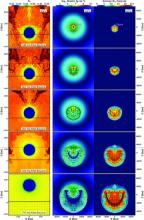
Abstract
We present results from a suite of axisymmetric, core-collapse supernova simulations in which hydrodynamic recoil from an asymmetric explosion produces large protoneutron star (PNS) velocities. We use the adaptive mesh refinement code CASTRO to self-consistently follow core collapse, the formation of the PNS and its subsequent acceleration. We obtain recoil velocities of up to 620 km s-1 at ˜1 s after bounce. These velocities are consistent with the observed distribution of pulsar kicks and with PNS velocities obtained in other theoretical calculations. Our PNSs are still accelerating at several hundred km s-1 at the end of our calculations, suggesting that even the highest velocity pulsars may be explained by hydrodynamic recoil in generic, core-collapse supernovae.